Reports
Health
Wellness
Transmembrane Protease, Serine 6 (TMPRSS6) gene is associated with the synthesis of transmembrane protease, serine 6 (also known as matriptase-2), a liver serine protease. TMPRSS6 cleaves the bone morphogenetic protein (BMP) and down-regulates the iron hormone hepcidin, facilitating iron absorption. Inactivation of TMPRSS6 is associated with iron deficiency anemia.
There are two single nucleotide polymorphisms associated with this gene, rs855791 and rs4820268. Variations in this gene are shown to be associated with serum iron, hemoglobin transferrin saturation and erythrocyte traits.
Iron is essential for production of blood and most of the body's iron (70%) is found in the red blood cells of the blood called hemoglobin and in muscle cells called myoglobin. Hemoglobin transfers oxygen in the blood from the lungs to the tissues. Myoglobin, present in muscle cells, transports, stores and releases oxygen.
Iron is also a constituent of certain proteins (6%) and is essential for energy metabolism and for respiration. It is a component of enzymes that are involved in the synthesis of collagen as well as for certain neurotransmitters. Iron is also required for optimum immune function.
Nearly 25% of the iron is stored as ferritin in the body.
| CHIP Version | TMPRSS6 SNPs |
| 23andMe (Use your 23andme raw data to know your TMPRSS6 Variant) | |
| v1 23andme | Present |
| v2 23andme | Present |
| v3 23andme | Present |
| v4 23andme | Present |
| V5 23andme (current chip) | Present |
| AncestryDNA (Use your ancestry DNA raw data to know your TMPRSS6 Variant) | |
| v1 ancestry DNA | Present |
| V2 ancestry DNA (current chip) | Present |
| Family Tree DNA (Use your FTDNA raw data to know your TMPRSS6 Variant) | |
| OmniExpress microarray chip | Present |
In a study conducted on 2100 elderly women, people with the T variant of the gene (rs855791) were associated with lower levels of serum iron and hemoglobin. In another study conducted on 14,100 Danish men, men with the T variant were shown to be associated with lower levels of iron.
In another study conducted on about 600 people, the G variant of the gene (rs4820268) is associated with lower hepcidin levels than the A variant.
| Genotype rs855791 | Phenotype | Recommendation |
| TT | [Limitation] More likely to have lower serum iron and hemoglobin levels | Likely decrease in iron levels Include chicken liver, pumpkin seeds, spinach, tofu, almonds and baked beans. Since there is a genetic predisposition for lower levels of iron, it is recommended to consume more than the daily recommended amount of iron |
| CT | Moderate level of serum iron | No genetic predisposition for lower iron levels so daily recommended level of iron may be consumed. Men should consume 8mg/day, women between 19-50 years should consume 18 mg/day and women over 50 years should consume 5mg/day |
| CC | [Advantage] More likely to have higher serum iron and hemoglobin levels | No genetic predisposition for lower iron levels so daily recommended level of iron may be consumed. Men should consume 8mg/day, women between 19-50 years should consume 18 mg/day and women over 50 years should consume 5mg/day |
| Genotype rs4820268 | Phenotype | Recommendation |
| GG | [Limitation] More likely to have lower hemoglobin levels | Likely decrease in iron levels Include chicken liver, pumpkin seeds, spinach, tofu, almonds and baked beans. Since there is a genetic predisposition for lower levels of iron, it is recommended to consume more than the daily recommended amount of iron |
| AG | Moderate level of hemoglobin | No genetic predisposition for lower iron levels so daily recommended level of iron may be consumed. Men should consume 8mg/day, women between 19-50 years should consume 18 mg/day and women over 50 years should consume 5mg/day |
| AA | [Advantage] More likely to have higher hemoglobin levels | No genetic predisposition for lower iron levels so daily recommended level of iron may be consumed. Men should consume 8mg/day, women between 19-50 years should consume 18 mg/day and women over 50 years should consume 5mg/day |
“Nutrigenetics, fitness genetics, health genetics are all nascent but rapidly growing areas within human genetics. The information provided herein is based on preliminary scientific studies and it is to be read and understood in that context.”
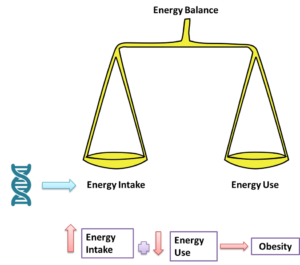
A healthy weight is maintained during a state of energy balance- when the energy intake of an individual matches the energy expenditure. Weight can accrue over a long period of time if the intake is higher than expenditure. Besides intake and expenditure, other factors such as age, basal metabolism, hormonal imbalance, and genetics also influence weight gain or weight loss.
Many humans have inherited genetic adaptations, which evolved to mitigate the ancestral exposure to cycles of feast and famine. Hence, the human body is very good at storing excess energy as fat and reluctant to lose valuable stores (fat) of energy. This is the basis of the ‘thrifty gene’ hypothesis, which explains why people easily put on weight on an excess calorie diet and find it very hard to lose it.
The heritability associated with energy intake among children is found to be between 47-69%. Twin studies showed that there was a genetic influence on the type of food consumed, along with satiety and food cue response.
There are many genes that have been shown to be associated with obesity and energy intake. Of particular significance is the FTO gene. Studies have shown that certain variants of this gene were associated with increased energy intake and increased hunger. Individuals with the abnormal FTO gene weigh at least 3kgs more than individuals who have the normal copy of the gene.
Individuals with an abnormal copy of the FTO gene eat more frequently, with a tendency to prefer calorie-dense foods and larger portions of food. People with the highest risk variant should exert portion control and eat a lot of food rich in fiber which would help quell the hunger. They should also consider frequent snacking in small quantities of low calorie, high protein, and high fiber foods to counteract the perpetual hunger they may be experiencing to maintain a stable glycemic index and stable levels of hunger and satiety hormones.
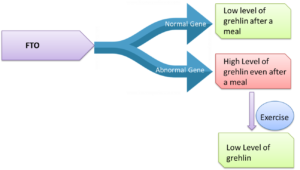
A hormone that plays a key role in satiety is ghrelin. Ghrelin is responsible for ‘hunger pangs’ as it signals the brain to eat. After a meal, the level of ghrelin is lowered and levels of another hormone, Leptin, are elevated resulting in a feeling of fullness. In an individual with the high risk variant of the FTO gene, the level of ghrelin remains high even after a meal, re
sulting in over eating. In such individuals, exercise has been shown to restore the level of ghrelin to normal levels.
Individuals with the abnormal FTO gene should be encouraged to follow a regular exercise pattern which will aid in lowering ghrelin levels and provide better satiety response.
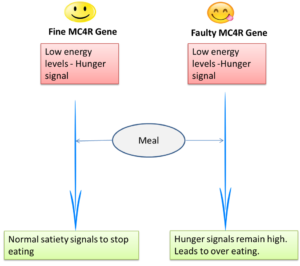
Another important gene that affects meal size and meal choice but not meal frequency is MC4R. When the energy levels drop in our body, the hunger center sends signals that inhibit MC4R and there is an increase in appetite. When the stomach is full after eating, satiety signals are sent by the satiety center that stimulates the MC4R to send signals to stop eating.
Overeating that is induced by distress, emotional eating, leads to binge eating which is highly prevalent in adults who are binge eaters or obese. Binge eating disorder is due to hypersensitivity to reward which results in overeating. The tendency to overeat or binge eat can be determined relatively strongly by analyzing the dopamine D2 receptor gene.
Dopamine is a neurotransmitter and its secretion is increased during emotional upheavals. From an evolutionary aspect, this hormone is released in response to some adverse condition, to prepare the body for a flight or fight response. Under normal circumstances, when dopamine binds to the DRD2 receptor, it should lower feelings of hunger and increase satiety. However, mutations in the DRD2 gene lead to a lower amount of DRD2 in the brain, which could lead to binge eating or overeating.
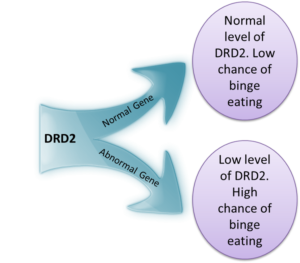
Individuals who carry the abnormal gene should consciously avoid overeating when feeling distressed or should store healthy snacks to eat at times of distress. Another study showed that deficits in the dopamine D2 receptor led mice to be inactive, which in turn lead to weight gain. Therefore, people with an abnormal gene should consciously stay active.
Regulating energy intake can moderate susceptibility to weight gain and obesity and is essential for people with a higher propensity to gain weight. Interventions that promote self-regulation of energy intake have the potential to control weight gain and also encourage healthy dietary habits. When designing intervention strategies, it is important to understand the genetic aspects involved as nearly 30% of obese individuals underreport their energy intake. The most effective way to fight obesity is through calorie restriction or lowering energy intake. People who carry abnormal genes for energy intake should follow mindful eating to ensure a balance in energy homeostasis.
Individuals who carry the abnormal gene should consciously avoid overeating when feeling distressed or should store healthy snacks to eat at times of distress. Another study showed that deficits in the dopamine D2 receptor led mice to be inactive, which in turn lead to weight gain. Therefore, people with an abnormal gene should consciously stay active.
Regulating energy intake can moderate susceptibility to weight gain and obesity and is essential for people with a higher propensity to gain weight. Interventions that promote self-regulation of energy intake have the potential to control weight gain and also encourage healthy dietary habits. When designing intervention strategies, it is important to understand the genetic aspects involved as nearly 30% of obese individuals underreport their energy intake. The most effective way to fight obesity is through calorie restriction or lowering energy intake. People who carry abnormal genes for energy intake should follow mindful eating to ensure a balance in energy homeostasis.
Find out which variations of these genes you carry and more at www.xcode.life
Nutrigenetics, fitness genetics, health genetics are all nascent but rapidly growing areas within human genetics. The information provided herein is to be read and understood in that context.
Since the start of Olympics in 776 BC, running has always been a remarkable event in the world of sport. This Rio 2016 is no exception and set to be another epic feast for running fans. The fundamental dimension of the Olympics is all about “Citius, Altius, Fortius” which translates to “Faster, Higher, stronger” and running itself abides by the same principle.
In the past, stories of sprinting successes by people of Jamaican heritage sparked interest in the genetic advantage that Jamaicans and people with West African ancestry might have, especially when it comes to raw muscle power.
[hr height="30" style="default" line="default" themecolor="1"]All of the diversity that is visible today among the 7 billion people on earth is the story of human genetic adaptation to their environment. For example, if the ancestors of certain people lived in hot and humid regions with significant sun exposure, they will have stronger skin pigmentation- which protects them from cancer causing UV rays. An example that is relevant to sports performance is that of ancestors who lived at higher altitudes above sea level. These places have lower levels of oxygen than what is found at sea level. As a result, their bodies have adaptations that make them efficient at extracting more oxygen out of the air they breath. All other things being equal, a person from higher altitude will have an advantage over someone from a lower altitude. Similarly, various other adaptations can be seen that offer specific advantages in various aspects of life. Of course, adaptations are only part of the story. The sheer human will to train and outcompete is the other part.
[hr height="30" style="default" line="default" themecolor="1"]
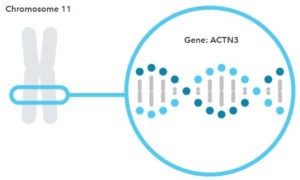
ACTN3 gene is the most widely studied sports performance related gene. The ACTN3 gene encodes instructions for making a specific muscle protein, ?-actinin-3, found exclusively in fast twitch muscle fibres. This protein is essential for greater strength & to protect against muscle damage which provides the benefits needed in speed or power based activity, such as sprinting or weight lifting.
There are different versions of ACTN3 gene and which version you carry determines how
much of the alpha-actinin-3 p
rotein you produce in your fast twitch muscle fibres. Some people have a fully functional version
that produces lot of alpha- actinin 3, commonly called the R allele. This is associated with a boost in muscle strength and sprint performance.
And some people have a non- working version of the gene, commonly called
the X allele that prevents it from making this protein and such people lack this protein in their muscles. Lack of this protein does not cause any harm to the body, but it does affect the level of athletic performance. It is probably close to impossible for someone who lacks this protein to reach the elite levels of sports performance especially in power based act
ivities, except for very rare cases.
Studies have indicated that people lacking the R allele of ACTN3 may have an advantage in endurance based sports. Such people also seem to have higher proportion of slow twitch muscle fibres and reduced fatigue which is advantageous in endurance performance.
Want to know if you have the “gene for speed?” Xcode’s fitness genetics test can tell you what versions of the ACTN3 gene you have in your DNA. You can also learn about how your genes may influence other traits, including your risk for certain diseases.
[hr height="30" style="default" line="default" themecolor="1"]
Stroke, a medical condition is characterized by rapid loss of brain function due to a disturbance in the blood supply to the brain. Stroke is sometimes called a “brain attack.” If blood flow is stopped for longer than a few seconds, the brain cannot get the required oxygen and nutrients through blood and eventually brain cells can die, causing permanent damage.
Sometimes referred to as cerebrovascular accident (CVA), stroke cause rapid loss of brain function due to a disturbance in the blood supply to the brain. This can be due to ischemia (lack of blood flow) caused by blockage (thrombosis, arterial embolism), or a hemorrhage (internal bleeding or loss of blood that occurs from the vascular system into a body cavity). As a result, the affected area of the brain cannot function, which might result in an inability to move one or more limbs on one side of the body, inability to understand or formulate speech, or an inability to see one side of the visual field. A stroke is a medical emergency and if untreated, it can cause permanent neurological damage and death.
[hr height="30" style="default" line="default" themecolor="1"]
[hr height="30" style="default" line="default" themecolor="1"]
Genes that have a vital role in regulating the blood & oxygen supply to the brain through formation & disruption of an atherosclerotic plaque are analyzed for variations which when present, imply that a person has increased risk for stroke.
Our unique genetic profile can make some of us more suitable for endurance activities, others for more intense sprinting activities or power training.
Genes involved in ‘endurance type of activities’ minimize muscle fatigue during prolonged period of mild to moderate intensity exercises, while genes involved in ‘sprinting’ relate to power, rapid bursts of energy, and optimum energy utilisation for activities of shorter duration. Depending upon the expression of Endurance/ Sprinting genes a person is categorized as adaptive for either of these.
There are two different types of muscle fibres which are important for these activities, each type being regulated by specific genes. Type I or slow twitch muscle fibres are mainly responsible for improving endurance. In contrast, Type II or fast twitch muscle fibres allow us to perform rapid, high intensity exercises.
It is a proven fact that regular exercise assures health benefits and improves your fitness level. It is noteworthy that genes determine your adaptability for the type, intensity and duration of activity (endurance/sprinting) based on your capacity for aerobic metabolism, extent of muscle fatigue and the time required for its recovery and slow/fast twitch muscle contraction. Therefore, based on specific variations within these genes in a person’s DNA, the type of exercise (endurance/sprinting) suitable for that person can be determined.
Upload your DNA raw data to Xcode Life. The Gene Fitness Report analyses endurance, weight loss or weight gain with exercise, and more than 15+ such traits.
Stretching is one of the most fundamental components of a fitness or exercise regime.
Performing stretching exercises before any fitness activity allows the body to become more flexible and less prone to injury. Stretching after exercise is also equally important. It allows the muscles to get back to their normal form and helps reduce muscle soreness and pain.
Flexibility is attributable to the protein collagen that surrounds cells. In fact, 25-30% of whole body protein is collagen! There are different types of collagens, each regulated by different genes. Collagen type V is important for flexibility. The more the flexible you are, the less you need to stretch before and after exercise. However, the presence of flexibility can lead to reduced exercise performance since more energy is required for muscle stabilising activity.
Flexibility is an indispensable aspect of fitness as it reflects the propensity for exercise-associated muscle injury. Your degree of flexibility and risk for tendinopathy as determined through genes are helpful in deciding the type and duration of your pre and post stretching exercises which would make your fitness regimen more comfortable for you to follow.
With over 30 million people diagnosed to be diabetic, India is well on its way to becoming the diabetes capital of the world!
Diabetes mellitus is a metabolic disorder that occurs when the body cannot regulate the production or usage of insulin. Insulin is a hormone that converts sugar, starches, and other food into energy. This energy is either used immediately or stored as fat or glycogen. In a diabetic, the body does not produce enough insulin to move the sugar into cells, and the sugar gets accumulated in the blood.
Type 2 diabetes occurs later in life and hence is referred to as adult-onset diabetes. In type 2 diabetes, the muscle and fat cells in the body become resistant to insulin which causes the pancreas to make more insulin. As long as the pancreas continues to produce insulin to overcome this resistance, blood glucose levels remain normal. However, after several years the resistance of the cells continues to increase and the pancreas begins to produce lesser insulin. This result in hyperglycemia (abnormally high levels of sugar in the blood) and the symptoms of type 2 diabetes start manifesting. Type 2 diabetes is most often seen in obese or overweight people and the elderly.
Type 2 diabetes is asymptomatic in the majority of the cases over a long period of time. If symptoms do occur, they include fatigue, increased hunger (polyphagia), frequent urination (polyuria) and increased thirst (polydipsia), blurred vision, erectile dysfunction, and poor wound healing.
Genes have a role in glucose metabolism, and genetic variations within these genes affect their function, thereby increasing the risk for type 2 diabetes.
Coronary heart disease (CHD) is a heart condition which usually results from plaque build-up inside the coronary arteries, which carry oxygen rich blood to the heart. A plaque formation, which is the deposition of cholesterol, narrows these blood vessels and reduces supply of oxygen and blood to the heart. CHD symptoms include shortness of breath and chest pain (angina), while heart attack is its serious manifestation.
Genes have a vital biological role in heart function, blood vessel health (endothelial function), cholesterol & triglyceride metabolism, inflammatory signaling and blood coagulation. There are certain variations in these genes, which have found to be associated with a high risk for Coronary Heart Disease.
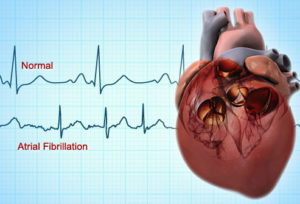
Atrial fibrillation (AF) is the most common type of arrhythmia. An arrhythmia is an abnormality in the heart beat or heart rhythm. During arrhythmia, the heart beat can be either too fast or too slow, or there can be an irregularity in heart rhythm. AF occurs if rapid, disorganized electrical signals cause the heart’s two upper chambers (atria) to fibrillate (contract very fast and irregularly).
Although ,atrial fibrillation itself usually isn’t life-threatening, it is a serious medical condition that sometimes requires emergency treatment as it can lead to other serious complications. Atrial fibrillation may lead to blood clot formation in the heart that may circulate to other organs and lead to blockage of blood flow.
Variations in important genes which have a role in the generation of electrical impulses in the heart muscle, affect the expression of these genes thereby increasing the risk for a disturbance in the contraction of atria leading to their dilation and fibrillation i.e., conferring a genetic predisposition towards AF.
[hr height="30" style="default" line="default" themecolor="1"]
Satiety can be defined as the ‘feeling of fullness’ after eating a meal. For example, have you ever wondered how you fill up with a bowl of oat meal but even three doughnuts leave you feeling hungry? The reason is the comparative satiety levels from the consumption of these foods.
Let us consider in more detail what happens during a meal. At the beginning, eating is rapid, with few pauses between bites. As the meal progresses, eating slows, there are more pauses between bites, and other behaviours such as fidgeting, grooming, or resting increase. A state of satiety is reached when the meal ends. This state is usually associated with a pleasant sensation of fullness or satisfaction. However, unpleasant sensations of nausea and bloating can be associated with satiety following excessive food intake. Of interest is that even when eating has stopped altogether, the introduction of a new food can restart eating.
Genes are involved in the regulation of metabolic rate and energy expenditure which in turn influences body fat accumulation. Some individuals carrying a variation in this gene tend to have “Difficulty in Feeling Full” and are likely to overeat, and overeating in the long run in turn can increase the likelihood for health conditions like obesity.
A genetic test to identify this mutation in an individual followed by appropriate dietary recommendations to overcome this difficulty in feeling full (if mutation is present) will help an individual attain optimal satiety levels.
